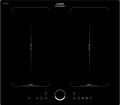Adaptive zone (FlexZone)
Special zones on the surface of the hob suggesting the possibility of using dishes of non-standard shapes and sizes. The FlexZone consists of several induction heating zones under a single glass-ceramic substrate, which are activated depending on the size of the installed cookware. Hobs with an
adaptive zone automatically recognize the presence of objects, and the simultaneous use of different types of dishes in this zone is also allowed.
Bridge mode
A function that allows you to combine two (or more) adjacent electric hotplates into one burner. Often, this mode is found in induction hobs, less often in Hi-Light, and is not used in gas hobs. Often the "bridge" looks like one continuous heater of an elongated shape, the individual parts of which can be turned on independently and are separate burners. Anyway,
the bridge mode (Bridge) can be useful primarily for working with elongated utensils — for example,
goose roasters. In addition, the design may provide various additional functions — for example, the ability to set different power settings for different parts of the "bridge" and move the dishes between them depending on the readiness of the dish. At the same time, unlike conventional burners, the heating will turn on automatically, according to the presence of dishes on the burner.
Burners power
Nominal burners power. It refers to the power consumption of the heater. This parameter allows you to estimate how much electricity the burners will spend when operating at maximum heating intensity. At the same time, the heat transfer power of different burners can be different, and the actual heating efficiency will also greatly depend on the specs of the dishes. As a result, it hardly makes sense to evaluate the working capabilities of the hob by the power of the burners. It is quite possible to proceed from the fact that the burner will be enough for a pot of the same diameter.
Number of power levels
The number of temperature settings of the burner. The more power levels, the more accurately you can set the required temperature for cooking a particular dish. However, in most cases, nine levels are enough for home use. But, if you are a gourmet and often cook unusual dishes that require strict adherence to the recipe, then you simply need more temperature settings.
Dimensions (WxD)
General dimensions of the device in width and depth. Depth, in this case, refers to the distance from the leading edge to the trailing edge (when viewed from the user's side). Note that the external dimensions of the hobs are often larger than the dimensions for embedding (see below).
Cut-out dimensions (WxD)
The size of the opening that needs to be made in the kitchen countertop for the normal embedding of the hob. By default, the width and depth are indicated — the size of the opening along the front and side sides, respectively (when viewed from the user's side). Note that the dimensions of the hob itself are usually larger than the dimensions for embedding: when installed in an opening, the upper part of the surface rests on its edges, so that the device does not fall into the countertop.

